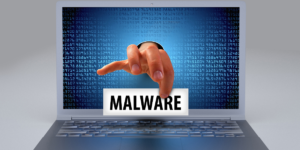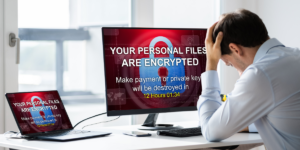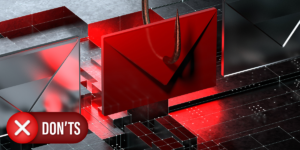Imagine, one morning, you get an anonymous call, and the caller says that he has locked and encrypted all your important files and asks for a ransom to give you access to your files. This nightmare scenario is precisely what Cryptolocker ransomware is capable of, and it’s a growing threat that can cause significant damage to both individuals and businesses.
In recent years, we’ve seen a rise in increasingly sophisticated cybersecurity threats, and Cryptolocker ransomware is one of the most insidious. Cybercriminals design Cryptolocker ransomware to sneak onto your computer, encrypt your files, and demand payment in exchange for the decryption key.
The consequences of a successful attack can be disastrous, leaving victims with lost data, financial losses, and reputational damage. That’s why it’s more crucial than ever to understand Cryptolocker ransomware in and out.
What is CryptoLocker Ransomware?
CryptoLocker is a type of ransomware and a well-known type of malware that can cause significant harm to any organization that relies on data. Once activated, it encrypts files on individual computers and networked drives, holding them hostage and demanding payment in exchange for the decryption key.
CryptoLocker and other similar types of malware can infiltrate a secure network in various ways, such as through email, file-sharing sites, and downloads. Even with antivirus and firewall technologies in place, new variants of this malware have been successful at evading detection. New versions will likely continue to emerge that circumvent existing protective measures.
So, Where Did This Malicious Malware Come From?
CryptoLocker first came into existence in September 2013 as part of a prolonged cyber attack that continued until May of the following year. The attackers used social engineering tactics to trick victims into opening malicious email attachments that contained Trojan horse malware.
This malware would then execute and infect the victim’s computer. To increase its reach, the attackers utilized the infamous Gameover ZeuS botnet, which enabled them to remotely control infected computers without the knowledge or consent of their owners.
Eventually, in mid-2014, an international task force called Operation Tovar succeeded in taking down Gameover ZeuS.
How Does a Cryptolocker Ransomware Attack Unfold?

During a Cryptolocker attack, the virus enters a computer through an email or spam message containing a weaponized attachment or a link to a malicious website.
These emails often appear legitimate, with attachments like invoices, shipping notices, fax reports, or Office documents. After you open the attachments, the Cryptolocker virus swiftly spreads and encrypts multiple files, including spreadsheets, presentations, Word docs, PDFs, and images.
After some time, a message appears on the user’s screen, notifying them that their data have encrypted and providing instructions on paying the ransom to receive the decryption code.
How to Detect CryptoLocker Ransomware
If you suspect that you might have become a victim of this virus, it is crucial to take measures to eliminate it from your system. There are multiple methods to identify if CryptoLocker has infected your computer.

Firstly, scrutinize suspicious emails or messages that prompt you to click links or download attachments. Secondly, examine the file extensions associated with the encrypted files utilizing asymmetric encryption.
Thirdly, review your browser history for any websites where you downloaded files. Fourthly, search your computer for files containing the terms “CryptoLocker” or “cryptolocker” in their name. Lastly, perform a malware scan on your computer using anti-malware software.
How to Prevent CryptoLocker Ransomware?
CryptoLocker only encrypts the files and folders that are accessible to the user account it is operating under. As a network administrator, you can minimize the impact by granting users access only to the necessary resources using the most petite privilege model.
However, this approach may not apply to securing your personal computer against CryptoLocker. Therefore, adopt safety measures to prevent CryptoLocker and other types of ransomware from infecting your computer.
Avoid Clicking on Unsafe Links
Refrain from clicking on links in spam messages or on unfamiliar websites. Clicking on malicious links can trigger automatic downloads that may infect your computer.
Be Cautious with Personal Information
If you receive a call, text message, or email from an untrusted source requesting personal information, avoid disclosing it. Cybercriminals planning a ransomware attack may attempt to gather personal information to customize phishing messages. When in doubt, directly contact the sender to verify the legitimacy of the message.
Don’t Open Suspicious Email Attachments

Ransomware can infiltrate your device through email attachments. Avoid opening attachments that appear suspicious. To ensure the email is trustworthy, carefully review the sender’s details and confirm that the email address is correct. Never open attachments that prompt you to run macros. Opening an infected attachment could execute a malicious macro, granting control of your computer to malware.
Don’t use unfamiliar USB sticks
Avoid connecting USB sticks or other storage media to your computer if their origin is unknown. Cybercriminals may infect storage devices and strategically leave them in public places to entice unsuspecting individuals to use them.
Keep Your Programs and Operating System Up to Date
Regularly update your programs and operating system to enhance your protection against malware. Install the latest security patches during updates to make it more difficult for cybercriminals to exploit vulnerabilities in your software.
Download from Trusted Sources Only
Minimize the risk of downloading ransomware by avoiding software or media files from unknown websites. Rely on verified and reputable sources for your downloads. Trustworthy websites often display trust seals and ensure the browser address bar shows “https” instead of “http”. Look for a shield or lock symbol in the address bar, indicating a secure page. Exercise caution when downloading content to your mobile device as well. Depending on your device, you can trust the Google Play Store or the Apple App Store.
Use VPN Services on Public Wi-Fi networks
When using public Wi-Fi networks, employing a VPN service is a prudent precaution against ransomware. Public Wi-Fi networks make your computer more vulnerable to attacks. To stay protected, avoid conducting sensitive transactions over public Wi-Fi or use a secure VPN service.
Bottomline
Solutions that cover all potential malware infections are essential in preventing cyber attacks. However, deploying, monitoring, and managing these solutions effectively requires a cybersecurity platform with centralized management and automation.





